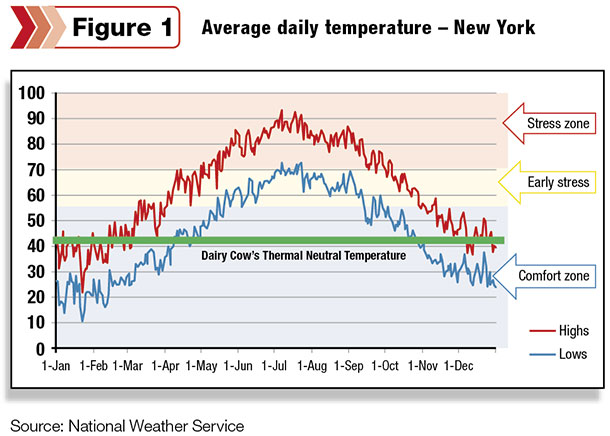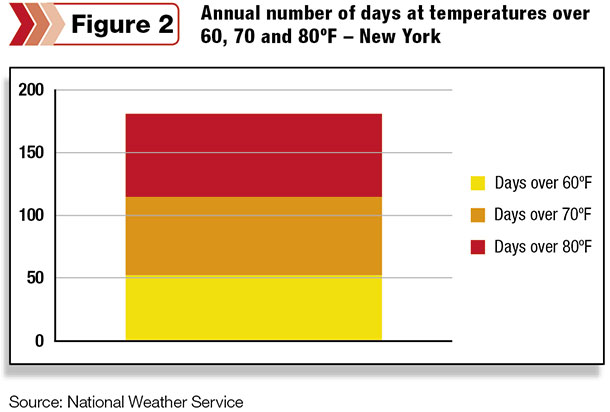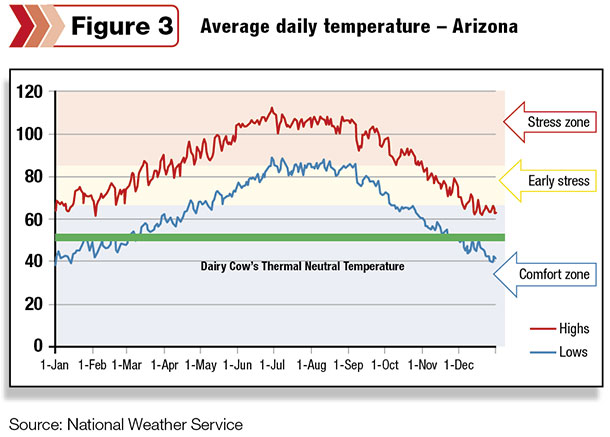As summer winds down, there is no better time to reflect on how much our herds were impacted by heat stress. The results may surprise you!
In an average year, how many days do you think the temperature in central New York state never reaches above freezing? The answer: 16 days per year. How about the same location reaching above 80ºF? On average, 66 days per year are above 80ºF in central New York (see Figure 1 and 2). What does this mean? Your cows are feeling heat stress a lot more than you may realize.

The most comfortable ambient temperature for a dairy cow is somewhere between 40 and 45ºF. In fact, if cows had a choice, they would rather feel those colder temperatures than the warmer ones. The latest research shows that early reproduction losses can start as low as 55ºF and that mild to moderate heat stress occurs at a temperature humidity index (THI) of 68. To put that into perspective with our example of central New York, that equates to two solid months a year that cows are reaching the severe heat stress range.
Based on this research, it is recommended that fans be turned on by 55ºF in order to help maintain a consistently comfortable environment. There are several different ways to start your fans at lower temperatures without breaking the bank. Staging fans with thermostats allows you to provide airflow that increases as the cows’ needs increase.
Variable frequency drives (VFD) and variable speed fan motors start fans and ramp up the speed as the temperature increases. With these options, the window of opportunity to provide relief from heat stress is very wide. In many parts of the country, fans can be running effectively for six months or more a year.

As the THI reaches 68, all of the fans should be running. Combined with water-cooling (i.e., sprinklers or misters), the benefits of these systems far outweigh the additional cost. Heat abatement is one of the few investments that will improve nearly all aspects of performance. From conception to feed intake and from milk quality to components – a small per-cow investment can result in huge paybacks.
Now what about those folks who live in hotter climates such as Florida or arid Arizona? Perhaps you think that the cows are used to the heat or the humidity isn’t so bad. However, hot is still hot. Cows in warmer climates will adjust to higher temperatures, but in extreme heat, they are still going to stress. In terms of THI, 100ºF with very low humidity results in the same heat stress level as 80ºF and higher humidity. On average, there are more than 100 days above 100ºF in Arizona each year (see Figure 3). Many of these days provide little or no overnight relief, making heat abatement even more important.

Let’s not forget that perspective is reality. People typically find 68 THI comfortable, or maybe even a bit chilly. While walking around the farm in long sleeves and sweatshirts, we may not realize that cows are starting to stress. In order to better accommodate your cows’ needs, many organizations are offering heat stress apps for iPhones and smart phones. These apps alert the user when the THI has reached a dangerous level, reminding producers to turn on fans and cooling.
Of course, heat stress apps only tell us when the ambient temperature outside of the barn reaches a level of heat stress. Remember that cows confined or crowded in small spaces create more heat. The temperature inside of the barn or in the holding areas may be much different than the temperature outside. Fans and cooling are needed in the holding area long before other areas of the barn. The thermostat or THI controls work well to help take the guess work out of providing heat stress relief.
Remember, dairy cows are susceptible to heat stress much sooner than people. We might feel that the barn is comfortable, but the herd is already suffering. Heat stress impacts your bottom line in more ways than you realize. It is important to be proactive and develop a heat abatement program. Summer may be winding down, but the effects of heat stress are sure to stick around. How much will you let heat stress effect you? PD
Suzanne Meck is with CowKühlerZ. Email Suzanne Meck.





